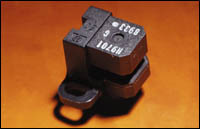| The
HEDR-5300 is ideal for detecting motion where space is constrained, while
the HEDS-9730 makes closed-loop control very cost competitive.
Translating Rotary
Motion Into a Two-Channel Output
The HEDR-5300 series contains a Light Emitting
Diode (LED) light source, an integrated circuit with detectors and output
circuitry, and a reflective codewheel. The LED and detector are mounted in
a single IC package which contains two lenses molded into the top. The
lens over the LED focuses light onto a reflective codewheel that rotates
above the emitter and detector. Light is either reflected or not reflected
back to the lens over the photodetector IC.
As the
codewheel rotates, an alternating pattern of light and dark that
corresponds to the codewheel's pattern, falls upon the photodiodes. This
light is used to produce internal signals: A and A' and B and B'. As part
of the "push-pull" detector system, these signals are fed through
comparators that are part of the signal processing circuitry to produce
the final outputs for channels A and B, which are two square waves in
quadrature.
Quick and Easy
Assembly
With
the HEDR-5300, the emphasis is on easy assembly. The encoder was designed
to be quickly mounted to a motor. Power and signal connections are made
through a standard four-pin connector located at the top face of the
encoder's cylindrical housing. The HEDR-5300 is ideal for applications
such as printers, plotters, and other motion control systems.
Detecting Linear or
Rotary Motion
The HEDS-9730 makes it possible to have sophisticated motion
detection at a low cost. The C-shaped emitter/ detector module, when
coupled with a codewheel, translates rotary motion into a two-channel
digital output. When the module is paired with a codestrip, it translates
linear motion into a digital output. Typical applications include
printers, plotters, and office automation equipment. The standard
HEDS-9730 is designed for use with an 11 mm or 23.36 mm optical radius or
a linear codestrip. |

Integrated Phasing
Technique
The
module contains a single LED as its light source. The light is collimated
into a parallel beam by a single lens located directly over the LED.
Opposite the emitter is the integrated detector circuit consisting of
multiple sets of photo detectors and the signal processing circuitry
needed to produce the digital waveforms. Because of the light source and a
unique photodetector array, the module is extremely tolerant to mounting
misalignment.
The codewheel/codestrip moves
between the emitter and detector, causing the light beam to be interrupted
by the codewheel/codestrip's pattern of spaces and bars. As the photodiode
outputs are fed through the signal processing circuitry, two comparators
receive these signals and produce the final outputs for channels A and B.
Because of this integrated phasing technique, the digital output of
channel A is in quadrature with channel B (90 degrees out of phase).

Conclusion
Hewlett-Packard's
HEDR-5300 and HEDS-9730 optical encoders offer two-channel output, high
performance, low cost, and small size for high-performance motion
detection. |


